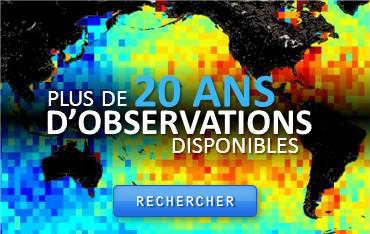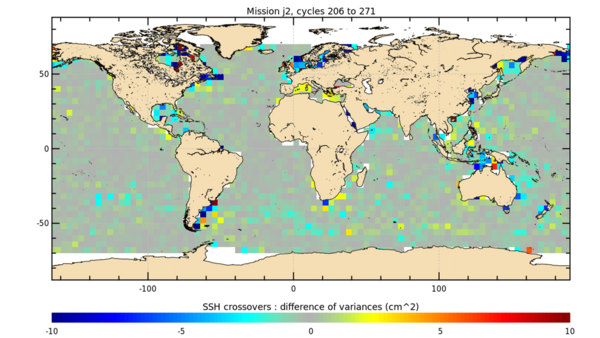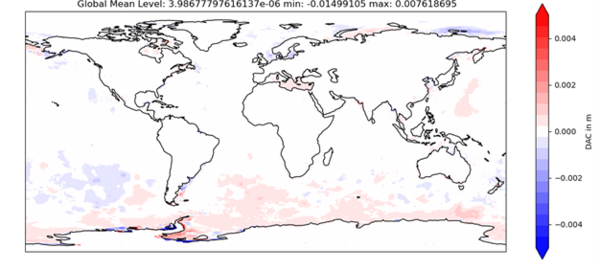August 2023: Evolution of the DAC correction: implementation of the new version V4.0
The calculation of the Dynamic Atmospheric Correction (DAC) is improved with the new version V4.0 as described below.
The Dynamic Atmospheric Correction
The Dynamic Atmospheric Correction (DAC) allows taking into account the dynamic response of the ocean to atmospheric forcing for high frequencies. The current operational DAC V3.5.1 is composed from the high frequencies of the barotropic ocean model MOG2D, forced by ECMWF operational wind and pressure fields and the low frequencies of the IB (Inverse Barometer, Carrere and Lyard, 2003). The cut-off of the filtering frequency is 20 days and corresponds to the Nyquist frequency of the reference TP/Jason altimeters which have a 10 day cycle. DAC is therefore capable of removing almost all the high-frequency dynamic signal forced by the atmosphere (pressure and wind) and aliased in the altimetric measurement, except for the errors and uncertainties of the model.
Main improvements of the new version V4.0:
- Using a new bathymetry database, coming from FES2014 global tidal solution.
- Update the barotropic model version, to fit with TUGO model (Pineau-Guillou 2018): include updates of the internal wave-drag dissipation parameters and some other internal parameters.
- The interpolation of the pressure and wind ECMWF variables has been improved.
- ECMWF library has been updated from grib_api 1.23 to ecCodes 2.20.
The map below shows that new DAC V4.0 solution reduces significantly the crossovers SSH variance on the global ocean compared to the operational DAC V3.5.1 solution: variance reduction can reach more than 5-10 cm² in coastal and shelf regions.
Regional biases between both DAC solutions
The new DAC V4.0 solution has been running in parallel with DAC V3.5.1 for several months. It improves the DAC compared to current solution, and only slight regional biases are observed over the ocean (see Figure 2): we observe very weak mean differences between the 2 solutions in most global ocean areas, below a few mm, and less than 1 mm in deep ocean. The mean global bias on the ocean reaches only 3.98.10-3 mm.
The mean differences between both DAC solutions is mostly zero on earth and hydrological regions.
Entry into service
The DAC V4.0 solution will be used from
- 29 August 2023 06h onwards for NRT & STC applications.
Impacted products distributed by AVISO+:- IGDRs and OGDRs of all missions.
- 09 August 2023 06h onwards for NTC applications.
Impacted products distributed by AVISO+:- GDRs of all missions.
- DAC delayed product: note that the format of the files remains the same, except for the version number attribute, which will be increased to V4.0 (netcdf global attribute ‘MOG2DVersion’), and only the scientific content of the variable ‘Grid_0001’ will change.
References
Carrère, L., and Lyard, F. (2003), Modeling the barotropic response of the global ocean to atmospheric wind and pressure forcing - comparisons with observations, Geophys. Res. Lett., 30, 1275, https://doi.org/10.1029/2002GL016473 , 6. L.
Carrere, Y. Faugère, F. Lyard, D. Allain, G. Dibarboure, N. Picot (2019), Last TUGO model simulations and perspectives of evolution of the Dynamic Atmospheric Correction for altimetry, poster presentation at OSTST 2019,
Carrere L., M. Lievin, C. Kocha, Q. Dagneaux, F. Lyard, D. Allain, Y. Faugère, G. Dibarboure, N. Picot (2020), Using ERA5 to improve the Dynamic Atmospheric Correction for altimetry, oral presentation at OSTST 2020,
Lucia Pineau-Guillou. Ocean-atmosphere interaction: improvement of wind stress for coastal physical modelling. Earth Sciences. Université de Bretagne occidentale - Brest, 2018. English. ⟨NNT : 2018BRES0064⟩.



















